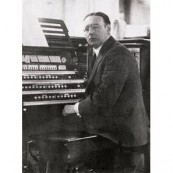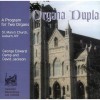传记
Healey Willan, CC (12 October 1880 in Balham, London – 16 February 1968 in Toronto, Ontario) was an Anglo-Canadian organist and composer. He composed more than 800 works including operas, symphonies, chamber music, a concerto, and pieces for band, orchestra, organ, and piano. He is best known for his religious music.
Willan was born in England, and he began musical training at age eight, with studies at St. Saviour's Choir School in Eastbourne.[1] He continued at St. Saviour's until 1895, when he began working as organist and choirmaster at several London-area groups. He was admitted to the Royal College of Organists in 1897 (Associate) and in 1899 was made Fellow. In 1903 he became the organist and choirmaster of St. John the Baptist Church on Holland Road in London. He became a member of the London Gregorian Association (a society to preserve and revive "plain-chant") in 1910. He continued at St. John the Baptist Church until 1913, when he emigrated to Canada.[2]
In 1920 Willan moved to Toronto to assume the title of Head of the Theory Department of the Toronto Conservatory of Music (now the Royal Conservatory of Music), of which he was advanced to Vice-Principal. He remained as Vice-Principal until 1936.[2] Among his notable pupils were pianist Howard Brown, tenor Gordon Wry, and composers Patricia Blomfield Holt, Walter MacNutt, and Kenneth Peacock. In addition to his duties at the Toronto Conservatory, Willan became organist and choirmaster at the church of St. Paul's, Bloor Street. In 1914 he was named Lecturer and Examiner at the University of Toronto. In 1921 he was named as Precentor of the Church of St. Mary Magdalene (Toronto), which became a mecca for church musicians (he retained that title until his death). In 1934 he founded the Tudor Singers, which he conducted until 1939 (when it disbanded).[3] In 1937 he was appointed Professor of Music at the University of Toronto, which post he retained until his 1950 retirement; he also served as organist for the University.
In 1956 Willan received the Lambeth Doctorate, Mus. D Cantaur from the Archbishop of Canterbury.
Willan was made a Companion of the Order of Canada at its inception in 1967. He is frequently called "the Dean of Canadian composers."
While serving as the organist and choirmaster at St. Paul's Bloor Street, Willan became interested in the music programme at another Anglican church, the Church of St. Mary Magdalene. St. Paul's was an evangelical, low church; St. Mary Magdalene's, while much smaller, was notably high church or Anglo-Catholic. By 1920, Willan was assisting with choir practice. In 1921, he resigned his post at St. Paul's and turned his attention to St. Mary Magdalene's. He set about creating a great many liturgical works for use in the church's services. He remained at St. Mary Magdalene's until shortly before his death, last directing the choir in 1967.
Willan composed some 800 musical pieces, the majority sacred works for choir such as anthems, hymns and mass settings. His non-sacred opus includes some 50 choral works, 100 song arrangements for voice with piano accompaniment, many works for piano solo, for voice with instrumental accompaniment, two symphonies, a piano concerto, chamber works, incidental music for stage works, ballad operas, and at least one important opera (Deirdre).
In 1953, Willan received a commission to write an anthem for the Coronation of Queen Elizabeth II. The resulting anthem, O Lord Our Governour, continues to be frequently performed. Willan's friends clubbed together to pay for his fare to London, so that he could attend the ceremony in person.[5]
Willan’s considerable output includes orchestral, choral, organ and piano, and chamber works, as well as music for plays and one opera. He is best known for his organ and sacred works, which show evidence of his love for plainsong and Renaissance music. For example, many of his liturgical compositions are based on church modes that date back 500 years. Also, his vocal lines are more melismatic and his style more contrapuntal and rhythmically free than those of his contemporaries. Willan’s larger choral works, however, were very Romantic in nature. His rich harmonic palette and luxuriant, soaring melodies stand as testament to his admiration of both Brahms and Wagner. His music represents a unique and beautiful combination of styles: both an homage to the sacred music of five centuries ago and a reflection of the innovations of the Romantic/post-Romantic period in which he lived.







